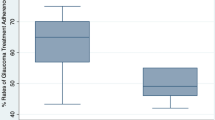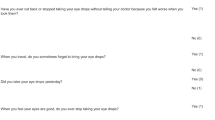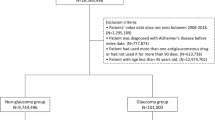Abstract
Aims and purpose
Adherence to long-term treatment regimens for primary open-angle glaucoma holds a challenge for both clinicians and patients. The study aims were to (i) establish the magnitude of travoprost non-adherence using an Electronic Adherence Monitor (EAM), (ii) compare electronic with patient self-reported adherence, and (iii) explore the application of a previously reported method of graphically presenting adherence data to a larger cohort over a longer monitoring period.
Methods
A cohort study of patients using travoprost for glaucoma or ocular hypertension was conducted. All participants used an EAM and adherence data were collected prospectively for 2 months. Self-reported adherence was obtained using the Morisky Medication Adherence Scale (MMAS); patients also reported frequency of missed doses. Potential predictors of adherence were collected via a structured interview. EAM-recorded interdose intervals were plotted graphically.
Results
Of 100 patients invited to participate, 98 consented and EAM data were collected successfully from 88 participants. The median EAM adherence score for the cohort was 88.9% (interquartile range: 71.2, 92.2). When dichotomised (≥80%: adherent; <80%: non-adherent), EAM identified 36.7% as non-adherent and MMAS 12.2%. EAM data were used to classify five types of adherence behaviour including a category representing levels of ≥97% maintained by 21% of participants.
Conclusion
EAM revealed good adherence to glaucoma monotherapy but poor agreement with patient self-reported adherence. An adherence category of persistent and exceptionally high adherence to travoprost over a 2-month period was identified.
Similar content being viewed by others
Log in or create a free account to read this content
Gain free access to this article, as well as selected content from this journal and more on nature.com
or
References
Lee PP, Walt JW, Rosenblatt LC, Siegartel LR, Stern LS . Association between intraocular pressure variation and glaucoma progression: data from a United States chart review. Am J Ophthalmol 2007; 144: 901–907.
Okeke CO, Quigley HA, Jampel HD, Ying GS, Plyler RJ, Jiang Y et al. Adherence with topical glaucoma medication monitored electronically the Travatan Dosing Aid study. Ophthalmology 2009; 116: 191–199.
Kass MA, Gordon M, Meltzer DW . Can ophthalmologists correctly identify patients defaulting from pilocarpine therapy? Am J Ophthalmol 1986; 101: 524–530.
Kass MA, Gordon M, Morley RE, Meltzer DW, Goldberg JJ . Compliance with topical timolol treatment. Am J Ophthalmol 1987; 103: 188–193.
Cate H, Broadway DC . Association between intraocular pressure and adherence: is there one? Eye (London) 2011; 25: 1238–1239.
Winfield AJ, Jessiman D, Williams A, Esakowitz L . A study of the causes of non-compliance by patients prescribed eyedrops. Br J Ophthalmol 1990; 74: 477–480.
Sleath B, Robin AL, Covert D, Byrd JE, Tudor G, Svarstad B . Patient-reported behavior and problems in using glaucoma medications. Ophthalmology 2006; 113: 431–436.
Robin AL, Novack GD, Covert DW, Crockett RS, Marcic TS . Adherence in glaucoma: objective measurements of once-daily and adjunctive medication use. Am J Ophthalmol 2007; 144: 533–540.
Morisky DE, Green LW, Levine DM . Concurrent and predictive validity of a self-reported measure of medication adherence. Med Care 1986; 24: 67–74.
Olthoff CM, Schouten JS, van de Borne BW, Webers CA . Noncompliance with ocular hypotensive treatment in patients with glaucoma or ocular hypertension an evidence-based review. Ophthalmology 2005; 112: 953–961.
Sackett D, Snow J . Magnitude and measurement of compliance. In: Haynes B, Wayne TD, Sacket D (eds) Compliance in Healthcare. The John Hopkins University Press: Baltimore and London, 1979.
Kulkarni SV, Damji KF, Buys YM . Medical management of primary open-angle glaucoma: best practices associated with enhanced patient compliance and persistency. Patient Prefer Adherence 2008; 2: 303–314.
Sleath B, Blalock S, Covert D, Stone JL, Skinner AC, Muir K et al. The relationship between glaucoma medication adherence, eye drop technique, and visual field defect severity. Ophthalmology 2011; 118: 2398–2402.
Cronin TH, Kahook MY, Lathrop KL, Noecker RJ . Accuracy and performance of a commercially available Dosing Aid. Br J Ophthalmol 2007; 91: 497–499.
Friedman DS, Jampel HD, Congdon NG, Miller R, Quigley HA . The TRAVATAN Dosing Aid accurately records when drops are taken. Am J Ophthalmol 2007; 143: 699–701.
Nordmann JP, Baudouin C, Renard JP, Denis P, Lafuma A, Laurendeau C et al. Measurement of treatment compliance using a medical device for glaucoma patients associated with intraocular pressure control: a survey. Clin Ophthalmol 4: 731–739.
Ajit RR, Fenerty CH, Henson DB . Patterns and rate of adherence to glaucoma therapy using an electronic dosing aid. Eye (London) 2010; 24: 1338–1343.
DiMatteo MR . Variations in patients’ adherence to medical recommendations: a quantitative review of 50 years of research. Med Care 2004; 42: 200–209.
Haynes RB, McDonald HP, Garg AX . Helping patients follow prescribed treatment: clinical applications. JAMA 2002; 288: 2880–2883.
Benner JS, Glynn RJ, Mogun H, Neumann PJ, Weinstein MC, Avorn J . Long-term persistence in use of statin therapy in elderly patients. JAMA 2002; 288: 455–461.
Hermann MM, Bron AM, Creuzot-Garcher CP, Diestelhorst M . Measurement of adherence to brimonidine therapy for glaucoma using electronic monitoring. J Glaucoma 2011; 20: 502–508.
Friedman DS, Okeke CO, Jampel HD, Ying GS, Plyler RJ, Jiang Y et al. Risk factors for poor adherence to eyedrops in electronically monitored patients with glaucoma. Ophthalmology 2009; 116: 1097–1105.
McCambridge J, Butor-Bhavsar K, Witton J, Elbourne D . Can research assessments themselves cause bias in behaviour change trials? A systematic review of evidence from solomon 4-group studies. PLoS One 2011; 6: e25223.
Cramer JA, Scheyer RD, Mattson RH . Compliance declines between clinic visits. Arch Intern Med 1990; 150: 1509–1510.
Gupta R, Patil B, Shah BM, Bali SJ, Mishra SK, Dada T . Evaluating eye drop instillation technique in glaucoma patients. J Glaucoma 2011; 21 (3): 189–192.
Weis SE, Slocum PC, Blais FX, King B, Nunn M, Matney GB et al. The effect of directly observed therapy on the rates of drug resistance and relapse in tuberculosis. N Engl J Med 1994; 330: 1179–1184.
Granstrom PA . Glaucoma patients not compliant with their drug therapy: clinical and behavioural aspects. Br J Ophthalmol 1982; 66: 464–470.
Collins D . Pretesting survey instruments: an overview of cognitive methods. Qual Life Res 2003; 12: 229–238.
Blair E, Burton S . Cognitive-processes used by survey respondents to answer behavioral frequency questions. J Consum Res 1987; 14: 280–288.
Broadway D, Miglior S, Myers JS . Fluctuating intraocular pressure. J Glaucoma 2005; 14: 249–251.
Svarstad BL, Chewning BA, Sleath BL, Claesson C . The Brief Medication Questionnaire: a tool for screening patient adherence and barriers to adherence. Patient Educ Counsel 1999; 37: 113–124.
Rees G, Leong O, Crowston JG, Lamoureux EL . Intentional and unintentional nonadherence to ocular hypotensive treatment in patients with glaucoma. Ophthalmology 2010; 117: 903–908.
NICE. Medicines Adherence: Involving Patients in Decisions About Prescribed Medications and Support Adherence. National Collaborating Centre for Acute Care, National Institute for Health and Clinical Excellence: London, UK, 2009.
Denis P, Covert D, Realini A . Travoprost in the management of open-angle glaucoma and ocular hypertension. Clin Ophthalmol 2007; 1: 11–24.
Dubiner HB, Sircy MD, Landry T, Bergamini MV, Silver LH, Darell Turner F et al. Comparison of the diurnal ocular hypotensive efficacy of travoprost and latanoprost over a 44-hour period in patients with elevated intraocular pressure. Clin Ther 2004; 26: 84–91.
Gray TA, Orton LC, Henson D, Harper R, Waterman H . Interventions for improving adherence to ocular hypotensive therapy. Cochrane Database Syst Rev 2009; 15 (2): CD006132.
McIlraith I, Strasfeld M, Colev G, Hutnik CM . Selective laser trabeculoplasty as initial and adjunctive treatment for open-angle glaucoma. J Glaucoma 2006; 15: 124–130.
Nagar M, Ogunyomade A, O’Brart DP, Howes F, Marshall J . A randomised, prospective study comparing selective laser trabeculoplasty with latanoprost for the control of intraocular pressure in ocular hypertension and open angle glaucoma. Br J Ophthalmol 2005; 89: 1413–1417.
Acknowledgements
We thank Sally Edmunds, Donna Fisher, Corinne Haynes, Karen Le Grys and Naomi Waller, for their work collecting data and Tony Dyer (Norfolk Clinical Trials Unit) for designing the software programme to calculate adherence. We also thank Barbara Talbot and Michael Cudby for their contribution to the project as patient and public representatives.
Author information
Authors and Affiliations
Corresponding author
Ethics declarations
Competing interests
The authors declare no conflict of interest.
Rights and permissions
About this article
Cite this article
Cate, H., Bhattacharya, D., Clark, A. et al. Patterns of adherence behaviour for patients with glaucoma. Eye 27, 545–553 (2013). https://doi.org/10.1038/eye.2012.294
Received:
Accepted:
Published:
Issue date:
DOI: https://doi.org/10.1038/eye.2012.294
Keywords
This article is cited by
-
Concordance of Adherence Measurement Using Self-Reported Adherence Questionnaires and Medication Monitoring Devices: An Updated Review
PharmacoEconomics (2018)
-
Level of adherence to ocular hypotensive agents and its determinant factors among glaucoma patients in Menelik II Referral Hospital, Ethiopia
BMC Ophthalmology (2016)
-
Effectiveness and Cost of a Personalized Reminder Intervention to Improve Adherence to Glaucoma Care
Applied Health Economics and Health Policy (2016)
-
Pharmacotherapy and Adherence Issues in Treating Elderly Patients with Glaucoma
Drugs & Aging (2015)



